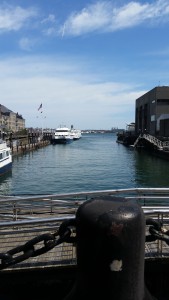Today (and mainly tonight) I made my way around Boston, completing the scavenger hunt. I worked alone but had the photographic help of a friend outside of the class, who I think learned a lot about Boston and our class in the process! Under the cut here are all of the hints I had to complete, accompanied with pictures and brief descriptions of the sites and their historical importance!
Boston-Franklin Scavenger Hunt
The Abiel Smith School, funded by philanthropist Abiel Smith, was the first public school for freed black children in the United States. It was constructed directly next door to the African Meeting house, creative a community for freed African Americans in Boston. The Abiel Smith School is a National Historic Landmark, and also part of the Boston Black Heritage Trail.
Louisburg square was named after the Battle of Louisburg, where a force of colonial militiamen, with the help of the British fleet and commanded by William Pepperell, a native of Kittery, captured the capital of the French colonial town of Louisburg in modern day Nova Scotia during King George’s War. The square has a statue of Columbus at one end and of Aristides the Just at another.
John Kerry owns a town house in the Beacon Hill neighborhood of Louisburg Square. He served in Vietnam, being awarded the Silver Star medal, the Bronze Star medal, and three purple hearts. He served on the United States Senate from 1984-2008. He ran for president in 2004 and lost to incumbent George H.W. Bush. In 2013, he was appointed to Secretary of State under President Barack Obama.
Horace Mann was a member of the Massachusetts State legislator and served on the Massachusetts State Board of Education. His life’s work was universal public education system and he began building schools on Massachusetts. He argued that in order to train unruly children to become respectable and responsible citizens, they must be sent to school and receive an education. Most states ended up adopting his system and soon, his idea of education for all spread across the nation.
Boston Common was established in 1634 and originally served the purpose of allowing farmers to bring their cattle to graze. However, the number of cows was limited to seventy, as the cattle were overgrazing American’s oldest city park. Mayor Harrison Gray Otis banned farmers from allowing their cattle to graze on the Common in 1830. Before the American Revolution, British troops camped on the Common, from which they marched to Lexington and Concord in 1775.
The Central Burying Ground was established in 1756 and has notable burials of Gilbert Stuart and William Billings. Gilbert Stuart was an artist who painted both George and Martha Washington’s portraits. The incomplete portrait of George Washington is used on US one dollar bill for over a century and various postage stamps from the ninetieth and twentieth century.
The statue of Benjamin Franklin at Old City Hall has four plaques representing different eras of his life. Two of these plaques illustrate Franklin’s political aspect of his life, including his involvement in the creating and signing of the Declaration of Independence, as well as the Treaty of Paris.
The Boston Athenaeum was founded in 1807 as an independent library, where members must pay a subscription to use its facilities and resources. It houses over one hundred thousand rare books, and an art collection of 100,000 paintings, sculptures, prints, drawings, photographs, and decorative arts. One of its most priceless artifacts is a bust of Benjamin Franklin, sculpted by Jean-Antoine Houdon, a famous French sculpture who created sculptures of Benjamin Franklin, Voltaire, and Napoleon Bonaparte.
By:
David Viviano
Matt Borges
Ian Ryan
Kaylee Lampert
Katie Flores
Mikhail Bryan
Alex Marcus
Scavenger Hunt
Today we went all around Boston taking pictures for a surprise scavenger hunt that Professor Allison sent us on. Please click the link above to view our little adventure, along with all the pictures that we took on our long walk. We saw many sights and statues that we never knew existed and learned a lot about them. Although it was cold and wet (very wet), the scavenger hunt was an overall great experience.
By,
Ashlee Backhus, Briana D’Amelio, Marissa Gudauskas, Karina Miranda, Rachel Neves, and Megan Scully
Group: Rachel Fancy, KallyMorse, Zach Castagnola, Jason Davidson, Tom Charpentier, Edwin Romero Munguia
Please click Creating America above and watch my groups power point of all of our scavenger hunt. If you don’t have the time to watch I’ll just post the highlight pics below.
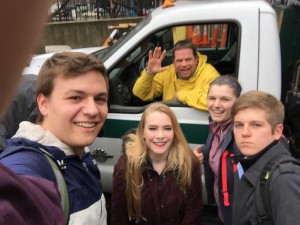
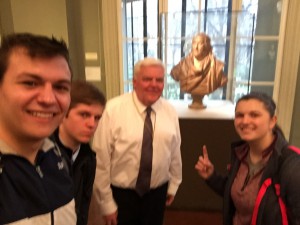
Honors Showcase – Layout/Timeline

Matt and I thought that this design would be a good general layout for the showcase. Each exhibit would portray a different part of Franklin’s life in a creative way. The exhibits would be in chronological order to help the viewers get a better sense of Franklin’s life.
The number of exhibits in the drawing is not the actual number of exhibits, but rather a concept design. This layout is also based on a lecture room with staggered rows.
We are still piecing together the timeline, and will have it ready for Tuesday.
Honors-Palooza Idea
For the “Honors-Palooza”, I was thinking that we could go with the proposed idea of having a timeline of important events in Benjamin’s Franklin’s life (this would include occurrences that shaped him into the man that we know today and innovations that he created over time). These events would be split up into different areas around the room and we would turn what we learned into a “tour” of some sort for the visitors to take part in.
I think that we should stick with the idea of having David (or whoever else volunteers) dress up as Franklin. However, I think that he should act as a “tour guide” and bring the visitors to each area (for lack of better word). Each area would be introduced by the “tour guide” and there would be students that have prepared a few words to say about or images of their specific occurrence/event in Franklin’s life at each area.
Once completed with the “tour”, we could possibly have some things that would be available to sell that could go toward funding the history department? Or we could even have small tokens of thanks instead that they could receive as they walk out of the room (such as a fake $100 bill or bar of soap as mentioned by some of our classmates prior). I think that interacting with our visitors is key and something that we should definitely do in order to keep them intrigued and interested!
Benjamin Franklin Honors Presentation Idea
Here is my idea for the honors event, a central theme to run with for this event, so that way all the different ideas people have can be connected to one main theme.
The theme can be Benjamin Franklin: The pathway to success.
We can have a small poster-board which can briefly outline the different parts of Benjamin Franklin’s life. For example: Franklin the author, Franklin the printer, Franklin the politician, etc. This way, more people can connect with Franklin on a topic and will better understand what they will expect once they enter our event
Overall, this theme will allow visitors to understand the different ideas and how they all correlate to Benjamin Franklin and also give our event a sort of coheiveness, so that it doesn’t seem like we are all over the place with different part’s from Franklin’s life.
Printing Press Trip
I managed to take these awesome pictures of Professor Allison on the field trip we took on February 2nd to view the printing press. I was blown away with how they got things printed back in the day. It was a lot more complex and I think we take for granted how much easier it has gotten for us. Back in the 1700s they would have to pre set every letter to make the sentence they needed. These letters would be very tiny and would be loaded onto something in which would hold the letters in place. The gentlemen in the photo next to Professor Allison explained to us that this took up a whole lot of time. I believe he said it would take something like eight hours to be able to preset al the letters for the words that would be on the whole page that was going to be printed. Once everything was ready to go you would load the preset words onto this platform where it would get pressed and printed onto a page. Then you would pull this lever and it would press and create one copy. They would do this several times in one day until they reached the amount that they needed. Professor Allison seemed like he had a tough time making one copy so I could not imagine making hundreds of them.
Overall the field trip we took was very informative. I enjoyed getting out of class and being able to learn so much about history and something in which Benjamin Franklin very likely assisted his brother in doing.
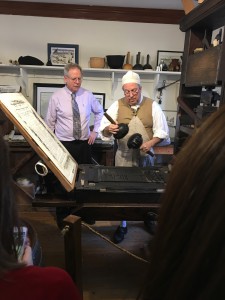
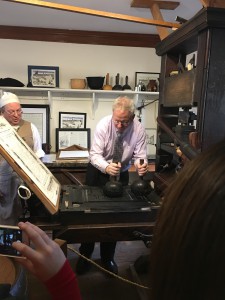
Pizza with the Profs!
On Wednesday, March 30, the history department hosted a social event titled “Pizza with the Profs!”. It provided an opportunity to have lunch, relax, and get to know fellow students and the staff of the History Department! Below are some pictures of the event!


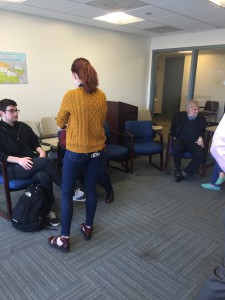
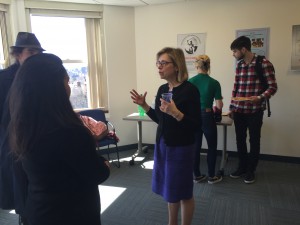
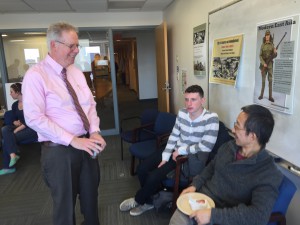
Field Trip
Here are two pictures from our field trip yesterday
